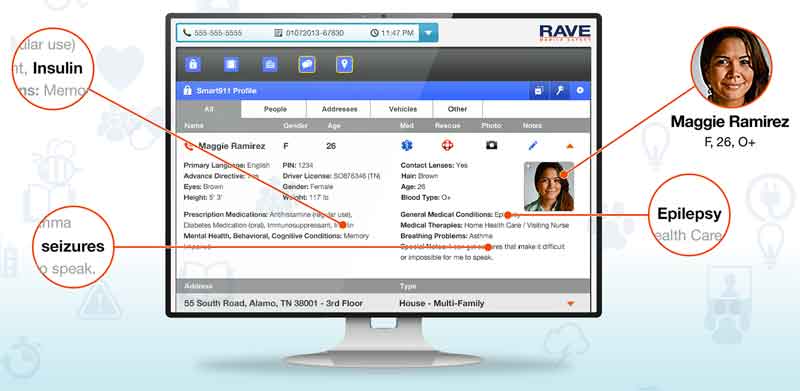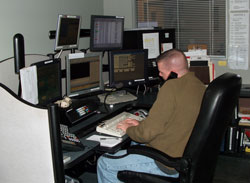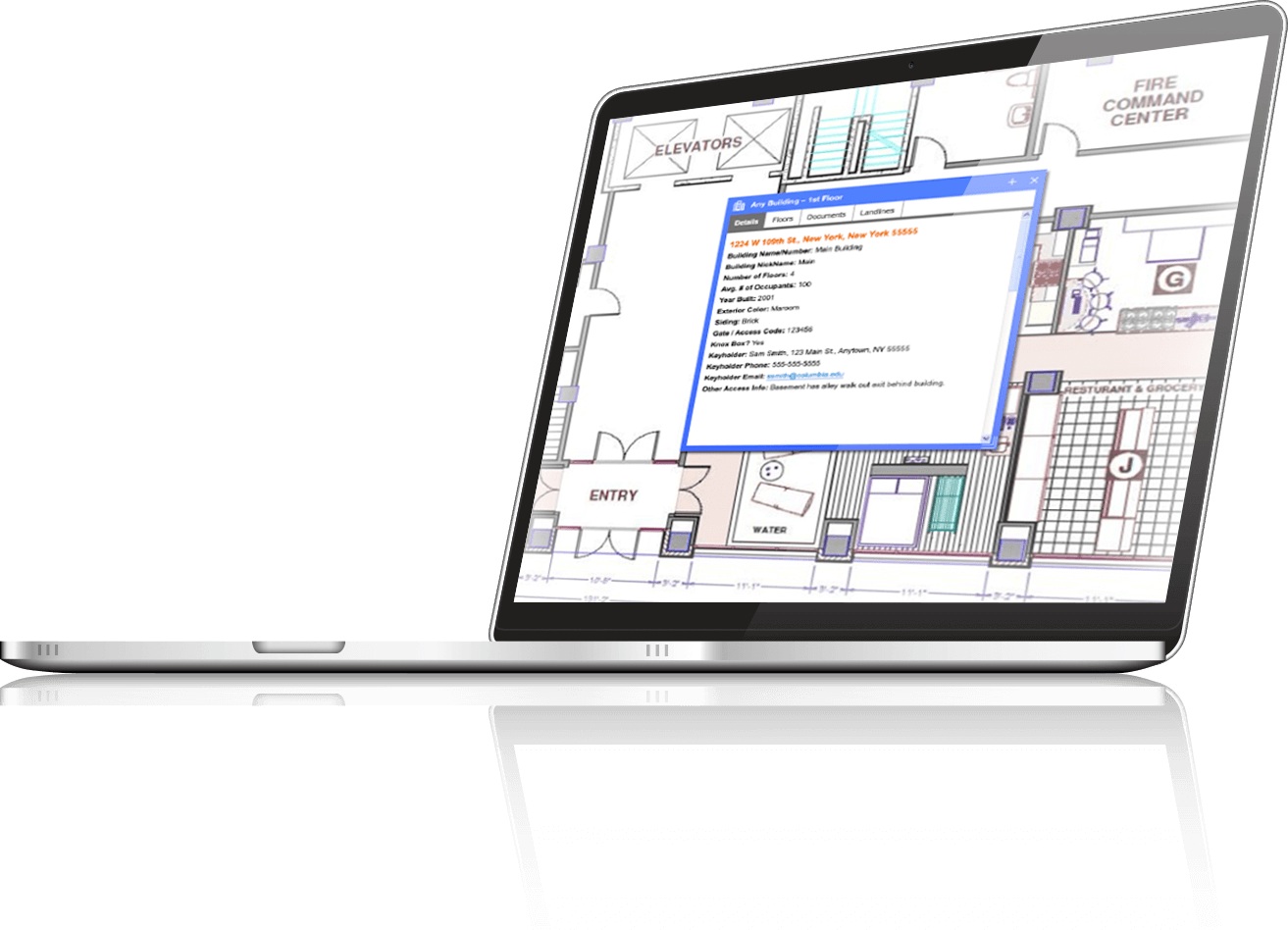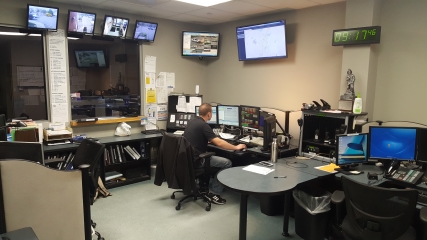The Communications Center is part of the Support Division and is under direct supervision of the Support Services Division Commander. Communications is staffed 24 hours a day, 7 days a week.
ENHANCED 9-1-1 SYSTEM

Also known as a Public Safety Answering Point or “PSAP” the Communications Center operates an enhanced 9-1-1 system. This means that all 9-1-1 calls received at this PSAP are displayed to a computer screen. The information available to a dispatcher will typically include the name, address and telephone number of the owner of the property and a list of those emergency services, i.e. police, fire and ambulance, that respond to that location. The communications center operates 24/7/365 and is supervised by the Support Services Division Commander.
The Enhanced 9-1-1 system is designed to speed the response to emergencies. The dispatcher does not need to solicit the information that is already displayed. In many instances callers are emotionally charged, which can consume valuable time. In every instance however, a dispatcher will verify the information with the caller to ensure that a response is made to the actual location of the emergency. It is not uncommon to receive a 9-1-1 call from an individual who had been speaking with a relative living in another town, when suddenly that relative falls ill and needs medical assistance.
 When you create a safety profile at Smart911.com, it gives our dispatchers the information they need to help you fast should you ever need to call 9-1-1.
When you create a safety profile at Smart911.com, it gives our dispatchers the information they need to help you fast should you ever need to call 9-1-1.
Safety Profiles
Smart911 allows you to create a Safety Profile for your household which will proactively provide details on your family and home that 9-1-1 dispatchers may need in order to send help in the event of an emergency. Smart911 then delivers this information automatically with any 9-1-1 calls that are routed to our 9-1-1 center.
Emergency Alerts
While creating your Smart911 profile, you can opt-in to receive emergency alerts.
Register at Smart911.com or download their app:
 What information is shared?
What information is shared?
You decide. Smart911 allows you to store any critical care and emergency rescue information online in advance of any emergency. Information can include children’s photos, medical conditions, home addresses of mobile phone callers, disabilities or other rescue-related information. When a 9-1-1 call is placed, this information is displayed to our dispatcher to provide a quicker and better informed response to your emergency.
DISPATCHER-INITIATED TEXTING
Our dispatchers can initiate 2-way text conversations with any mobile caller. If an emergency caller is non-verbal, disconnected, or has poor coverage, 9-1-1 call takers can easily contact them to send help or verify accidental dials.
Highly accurate wireless location information
 Our dispatchers play a vital role in helping police to locate missing persons, fugitives from the law, or others whose safety may be in jeopardy by locating cell phone and other wireless device subscribers.
Our dispatchers play a vital role in helping police to locate missing persons, fugitives from the law, or others whose safety may be in jeopardy by locating cell phone and other wireless device subscribers.
Using data from the RapidSOS Clearinghouse, our dispatchers have access to highly accurate 9-1-1 caller location data using best available smartphone technology including GPS, Wi-Fi, and beacons.
Aside from utilizing GPS and triangulated location portion of the enhanced 9-1-1 data from cell phone callers, dispatchers can work closely with police and wireless service providers to “ping” the location of a subscriber’s cell phone to locate them in an emergency. This capability has also been successfully used during the investigation of major crimes to provide evidence of an offender’s location.
Receive Emergency Alerts
When signing up for Smart911, you’ll also be prompted to choose which types of alerts you wish to receive. Newton’s emergency services use this platform to send emergency alerts via push notification, phone call, text messaging, email, and social media to notify the public about incidents that affect public safety and what actions may need to be taken. The Town of Newton also uses this to send certain types of non-emergency alerts and public information. You can select the types of notifications you want and how you want to be notified.
How do I register?
Head over to www.Smart911.com to create your Safety Profile. It’s free, private, and secure.
It’s important to keep the information in your Safety Profile up to date! Make sure you update your information whenever there is a change, and confirm any unchanged information no more than every six months to ensure that emergency responders are provided with accurate information when responding to an emergency.
Question: Can 9-1-1 operators access my Smart911 information even if I don’t call 9-1-1?
No. Smart911 information is only made available to 9-1-1 call takers when you call 9-1-1 from a phone that has been verified with your Safety Profile.
Newton Emergency Management utilizes Smart911’s advanced Emergency Management system, through which Emergency Managers can access information within your Safety Profile when planning for and responding to emergencies. Your profile is only searchable by Emergency Management if you live or work within our jurisdiction, and ONLY if you have elected to make information in your profile available to these agencies. If you provide an address within our dispatch area, you will be asked whether you wish to participate.
Question: Does my Safety Profile expire?
Smart911 requires you to log into your Safety Profile and confirm or update your information every 6 months. Even if no information has changed within 6 months, 9-1-1 call takers need to be assured that the information they are viewing during your call is accurate within the past 6 months.
Question: Can I receive emergency alerts without signing up for a full Safety Profile?
Yes. Click here to reach the login page and click on the "Register" button at the top right.
By creating a Rave Facility Profile for your facility, our dispatchers will be provided accurate site details alongside 9-1-1 calls originating from that facility. Information can include:
- Floor plans and maps
- Key Personnel
- Utility shutoff locations
- Hazardous material information
- AED locations
- Landline phone locations
- Lists of CPR/AED trained personnel
- …and more

Businesses and organizations which are located in multi-tenant properties should coordinate with their landlord or property owner to create one facility profile for each physical property location/campus and enter the emergency contact and other information on behalf of their tenants. Having one facility profile for each location is more simple and effective for our purposes.
Common Alerting Protocol (CAP)
 We send emergency alerts in various formats including Common Alerting Protocol (CAP) which allows the emergency alert messages we send to be instantly displayed on CAP-compliant devices such as computer monitors, digital signage, VOIP telephone screens, kiosks, and more.
We send emergency alerts in various formats including Common Alerting Protocol (CAP) which allows the emergency alert messages we send to be instantly displayed on CAP-compliant devices such as computer monitors, digital signage, VOIP telephone screens, kiosks, and more.
If your business or institution uses Alertus or other CAP-compliant solutions, contact Det. Sgt. Dan Finkle at dfinkle@newtonpolice.org or (973) 383-2525 x266 to learn how we can utilize these capabilities to increase public safety in your organization.
Text to 9-1-1
A voice call made from a wireline or cell phone is preferable, but in the event that you cannot do so safely or practically you can send a text to 9-1-1.
A voice call is always the best option. Talking to a 9-1- operator is the fastest way to relay your information, so the operator can send the right kind of help. However, if you’re in a situation where speaking could put you in danger, or if you have trouble hearing or speaking, sending a text to 9-1-1 could be your best option.
Your messages will be received by a text-capable 9-1-1 center and the operator will relay your message to our agency.
Keep in mind that if you are at risk, you must silence your phone, so you don’t put yourself into a potentially more harmful situation. If your phone makes a noise, you could reveal your location and put yourself in real danger.
Question: How do I send a text to 9-1-1?
How do you send a text to 9-1-1? First, open the message app on your phone or wireless device. When you're entering the text address, just type "911." You don't need to put any spaces or dashes between the numbers.
In the message field, type in your exact location, including the address and the name of the town or city. Be as detailed as you can. If you don't know the address, type in the names of the streets at the nearest intersection or a description of any landmarks nearby.
Next, give a brief description of the problem. Then, press "Send."
Keep your messages brief and to the point, and avoid using slang and abbreviations.
The 9-1-1 call taker will ask you questions, so never leave the conversation until the call taker has told you to do so.
Question: Can I send pictures and videos to 9-1-1?
Pictures and videos can't be sent to 9-1-1, so only use text.
Question: Can I include more than one person in my text conversation with 9-1-1?
Text-to-9-1-1 cannot include more than one person. Do not copy your emergency text to anyone other than 9-1-1. Wait until you are safe to notify others of your situation.
Question: Will it show my location?
Texting to 9-1-1 is different from making a voice call to 9-1-1 in this respect. When you make a voice call to 9-1-1, the call taker will typically receive your phone number and your approximate location automatically. This is called "Enhanced 9-1-1" or "E9-1-1." However, in most cases when you text 9-1-1 from a wireless phone, the call taker will not receive this automated information. For this reason, if you send a text message to 9-1-1, it is important to give the 9-1-1 call taker an accurate address or location as quickly as possible, if you can.
Question: How will I know if the service is not available?
If your device is not connected to a tower with Text to 9-1-1 service you will receive a message that Text to 9-1-1 service is not available and you should make a voice call or use a relay service.
HANG-UP OR MISDIAL 9-1-1 CALLS
This PSAP does receive a number of 9-1-1 calls where the caller disconnects with the dispatcher before speaking with anyone. The majority of these hang-up calls are by error but in some instances are discovered to be true emergencies. It is important for the caller to stay on the line in the event of an error. The dispatcher will need to gain as much information about the call before passing it along to patrol officers. The policy of the Newton Police Department is that we will investigate every hang-up 9-1-1 call to ensure that no emergency exists.
COORDINATION OF MUTUAL AID UNITS
During a large scale emergency which requires a large number of resources, dispatchers play an important role in coordinating units as they are responding to the scene.
Conversely, during a time that emergency units are unavailable or already committed to other incidents, dispatchers employ the agency’s mutual aid protocol to summons nearby available units that can assist.
EMERGENCY CALL HANDLING
 Every dispatcher receives special training in receiving and handling emergency calls. Each is also trained in providing emergency medical instructions over the phone to individuals who can or are willing to try to assist in a medical emergency or other hazardous condition. The Communications Center utilizes approved Emergency Medical Guide Cards in providing such instructions. To date these emergency protocols have been used successfully in medical emergencies involving heart attacks, stroke, shock, allergic reactions and childbirth.
Every dispatcher receives special training in receiving and handling emergency calls. Each is also trained in providing emergency medical instructions over the phone to individuals who can or are willing to try to assist in a medical emergency or other hazardous condition. The Communications Center utilizes approved Emergency Medical Guide Cards in providing such instructions. To date these emergency protocols have been used successfully in medical emergencies involving heart attacks, stroke, shock, allergic reactions and childbirth.
REQUIRED CERTIFICATIONS AND TRAINING
The Communications Center is operated by civilian personnel who are required to attain certain certifications and levels of training before being qualified to operate the communications desk. At a minimum an individual receives:
- 40 Hours Basic Public Safety Telecommunicator Course including the following topic areas:
- Interpersonal Communications
- Telecommunicator Role in Public Safety
- Overview of the Police Function
- Overview of the Fire Function
- Overview of the EMS Function
- Public Safety Telecommunications Systems
- Radio Broadcasting Rules and Procedures
- Public Safety Records Systems
- Telephone Techniques
- Enhanced 9-1-1 Systems and Operating Procedures
- Telecommunicator Legal Issues
- 32 Hours Emergency Medical Dispatch course, including the following topic areas:
- Roles, Responsibilities and Resource Allocation
- Legal & Liability Issues: National/State Standards
- Call Taking and APCO EMD Guidecard Information
- Chief Complaint Types Review
- Anatomy and Physiology
- Quality Assurance and Recertification
- Stress Management
- 8 Hours CPR/AED Training
- ICS 100, Introduction to the Incident Command System
- ICS 200, Basic Incident Command System for Initial Response
- IS-700, An Introduction to the National Incident Management System
- IS-800, National Response Framework, an Introduction
- Ongoing continuing education training is required to keep skills and certifications current
Once training is completed a dispatcher will be assigned to a veteran dispatcher for field training where the skills learned through basic training are refined and applied to real life situations. Several full and part-time dispatchers have additional certifications and training as fire fighters and emergency medical technicians and are part of local emergency service organizations in their own communities.
Many police officers begin their career in public safety as a dispatcher. If interested in a position, visit our employment page or contact Lt. Joseph D’Annibale at (973) 383-2525 or jdannibale@newtonpolice.org.
OUR AGENCIES
We supply direct dispatch service for the following agencies:
- Newton Police Department
- Newton Fire Department
- Newton First Aid Squad
- Newton Department of Public Works
- Newton Water and Sewer Utility
- Newton Parking Authority
- Newton Office of Emergency Management
- Newton Animal Control
We also process requests for a variety of other resources such as:


